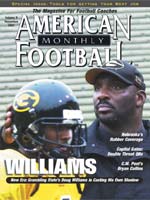AMERICAN FOOTBALL MONTHLY THE #1 RESOURCE FOR FOOTBALL COACHES
Article CategoriesAFM Magazine
|
The Last RepConcussions - Part Iby: Aaron S. Lee © More from this issue With each snap of the ball, football players are at constant risk for career-ending concussions. American Football Monthly has gathered seven of the industry’s top experts to discuss this epidemic in a Last Rep two-part series. AFM encourages coaches to use this platform as a first step in their continuing education on player safety. Please contact medical experts and gear manufacturers to learn the latest safety measures in dealing with concussions. What is a concussion? “The word ‘concuss’ in Latin means ‘to shake violently.’ A concussion is a metabolic change in the brain, it is not a structural ....The full article can only be seen by subscribers. Subscribe today!
|
|
|||||||
| HOME |
MAGAZINE |
SUBSCRIBE | ONLINE COLUMNISTS | COACHING VIDEOS |
Copyright 2025, AmericanFootballMonthly.com
All Rights Reserved





